Bagan artistry.
Inside the temples are sculptures and mainly wall art or murals decoration on ceilings and hallways, this are probably the more interesting since some show not only Buddha’s live but also the daily one of the people and other scenes, it’s an old picture gallery.
The temple interior walls provided enough space for artist to show their creative work. Paintings usually are not expressions of the artists vision and also not only decorative. The designer were painting scenes of religious history which finally also had a decorative purpose.These Burmese wall-paintings had been executed on dry walls not as frescoes on wet.
As it is visible in the pictures colors are mainly black, yellow, white, red and brown. The Pigments came from clay pounded into a fine powder and mixed with water and a binder mainly the gum from the neem tree.
The designAfter the walls have been divided into linear sections by a master artist depending on what was to be painted, other drawer worked on various sections at the same time. techniques used where similar to Pala art of easternIndia. The main features were first drawn in bold black or red outlines, after flat colors were applied and detail and ornament followed. The illusion of 3D was achieved by the placement and size of figures and overlapping. Mural Painting > People were shown as types and not as individuals recognized by their clothing, jewelry, head-gear and some other methods. Buildings, furniture, ox-cats, animals, trees, flowers, water and other objects were integrated into the scene in a very skillful technique. There is also lots of handicrafts techniques involved since in Myanmar they never made a real distinction between arts and crafts. Temple vaults were decorated with plenty of effigies of the Buddha with interlocking floral and geometric patterns somehow looking like arabesques. The top of a temple might show a lotus petal lake, a symbol of Brahma, hallways were sometimes painted with Buddha Footprints the symbol of Buddha’s eternal presence. Floral pattern represented the various heavens of the Buddhist Universe.
A frieze of Bodhi leaves, birds and other decorative elements where often created on the exterior walls. Also showing events of the Life of the Buddha and jataka stories depicting that all together there are more than 550 of them the medium to create the artwork is usually woodcarvings and sculpturing some rich people also used jadeite carvings read more.
This was old style custom mural paintings, somehow an expression
of the imagination of the artist within a strict framework given by the traditions
although there was space for creativity.
With this artwork large rooms were transforming in religious
spaces for mediation by donation kind of beautiful places with a magic aura.
Over time some new ideas and subjects were brought in but
rather limited, it was always about Buddha and Jakata Stories created by a professional
muralist who partitioned the piece of art into different scenes. They were done
one after another and always by the artist who had the best knowledge for that
particular part. That means first the drawings, after certain sections of the
painting etc. the faces were usually created by a master painter.
Looking at these compositions it is still amazing what creative images they created although there was no third dimension just like in the Egypt tombs. It took quite a while until the third dimension became visible to express our complex minds and ideas in a better way. This became works of art integrated into the overall visual.
There is no much difference to the famous works of Leonardo Da Vinci and this work made so far away, the main is in Europe it was a Catholic theme here it was a Buddhist. That is the same with the other mural painter in the “old world” where excellent artists did a good job and made many people visually happy. Today we enjoy their legacy here and there.
It is always amazing when watching the visitors in this places and what they are interpreting into the scenes. It's kind of magic how the interpretation is moved between the centuries but there is rarely much difference.
Now, what to do? Do something good for yourself get a kind of magic for yourself and visit Bagan in Myanmar to see the famous pagodas and temples some have the mural painting.
Murals are paintings done on the ceilings and walls of buildings,actually the surfaces are used as canvas for the artworks. They have a very long history since already in the Stone Age cave paintings where created around 30,000 BC. Later they have adorned the outer and inner walls of palaces, monuments, temples, tombs, shrines and other buildings. The work display ideas of the artists but are also often a copy of other artwork and follow the conventions built up over hundreds of years as with most wall art in the temples of Burma >. Most common old Myanmar frescoes are where the painting is done on the plastered walls using water based colors with lime wash and tempera where pigments have been diluted in water and bonded with egg yolk or some gum from the neem tree, that material is also used for lacquer ware. |






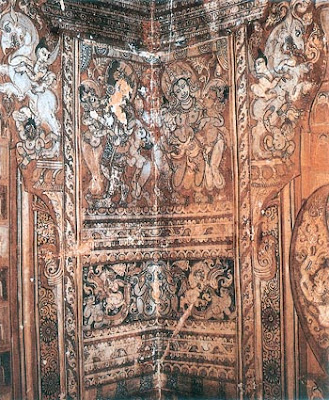

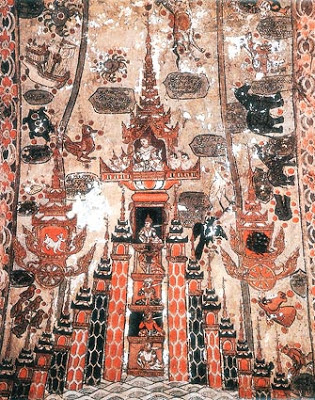


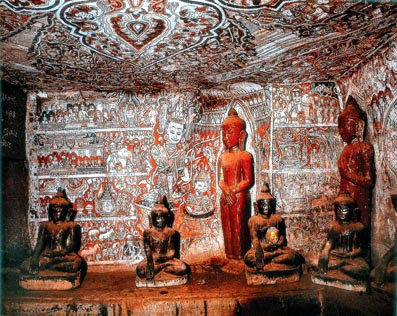



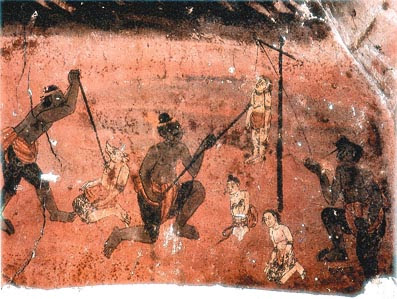




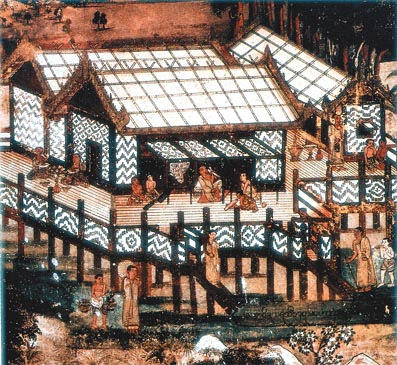
Great wall art paintings, this kind of murals are unique because of the natural pigments the colors were made from.
ReplyDeleteThanks for your valuable posting about Wall Murals it was very informative.
ReplyDeleteI am writing a book entitled "Splendor of Buddhism in Burma" and I would like to use some of these illustrations in the chapter on Old Burmese Wall paintings. How can we manage ? 1- I don't want to infringe any copyright law and 2- I would like to know from which temples the various illustrations are coming from
ReplyDeleteThanks. Pascal (answer at: pchrsa@outlook.com)